Propagating succulents is a great way to share your favorites with friends or expand your own collection, and they’re perfect for beginners to start with.
Though there are a few different methods you can use, rooting stem or leaf cuttings is by far the most popular and fun way to do it.
Below I’ll tell you all you need to know about how to propagate your succulents, and the best time to do it. I’ll walk you through everything step by step, from taking and preparing your cuttings, all the way through potting them up.
Succulent Propagation Methods
There are three basic ways that you can propagate succulents: 1. rooting cuttings, 2. by division, or 3. from seeds. The exact method to use depends on the type of plant that you have.
For example, you can easily root stems or leaves from jade plants, graptopetalum, or Christmas cactus. But for some species, like aloe vera, haworthia, or echeveria, it’s much easier to divide them.
Starting from seeds is also a fun experiment, and possible for most varieties. But it’s the slowest method and will take much longer to get sizable plants. In this guide, I will focus on how to propagate succulents from stem cuttings or leaves.
When To Propagate Succulents
The best time to propagate succulents is during the spring and summer months. Warm weather will make them root much faster.
In fact, it’s so easy that sometimes pieces will break off and start growing in the ground without any help from you. But, if you provide the right environment for them, you can do it during the winter too.
Propagating Succulents From Cuttings
There are two different types of cuttings you can use to propagate your succulents: either from the stem or individual leaves.
So be sure to keep your clippings when you’re pruning them, or if any of the branches are broken. Here are the pros and cons for each method:
- Stem cuttings – This is where you cut off an entire stem or branch and root it. It’s the easiest method, and will give you larger plants faster.
- Leaf cuttings – Many times you can use the individual leaves, but it’s usually more difficult. It also takes much longer to get mature plants, and it will not work for some varieties.
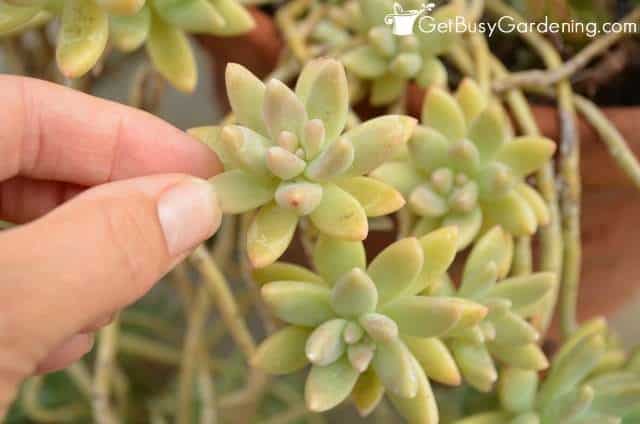
How To Take Cuttings
You can take succulent cuttings from anywhere along the stem, but it will be easier to propagate them if they’re at least 2-3 inches long.
Many times you can simply break off a section, and that will root just fine. But I recommend using a sharp and sterile pair of precision clippers or bonsai shears to remove them so they will get off to a healthy start.
Related Post: Succulent Plant Care & Ultimate Growing Guide
Properly Preparing Your Cuttings
After taking stem cuttings from your succulents, there are a few things you should do to prepare them for propagation.
If it’s covered by leaves, remove the lowest ones to expose a few inches of the stem. New roots will form from the leaf nodes, so you’ll definitely need to expose at least a couple of them. Don’t remove all of the leaves though.
It’s also important to allow the wound to cure (dry out and callus over) for a few days to help prevent rotting. The thicker the stem, the longer you should let it cure.
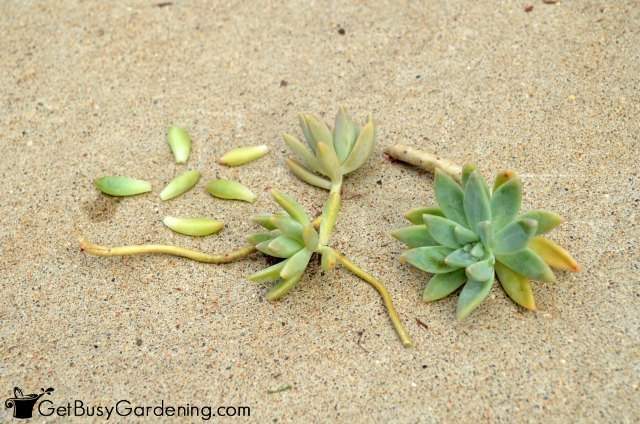
Tips For Propagating Succulent Leaves
To be successful with propagating your succulents from leaves, it’s important to remove each one correctly. You must break the entire leaf off cleanly, or it will not root.
To do that, hold onto the tip, and gently wiggle or twist it until it comes off. If they break in half in the process, or any part is left on the plant, discard that one and try again.
The leaves will shrivel pretty quickly after you remove them, especially if they’re small. So don’t wait too long to start them, or it might not work.
Once they have roots, a tiny plant will form at the base of the leaf. Then eventually the propagated leaf will shrivel up and die as the new baby succulent gets larger. So don’t freak out when that happens, it’s completely normal.
Related Post: How To Plant Succulents Indoors Or Outside
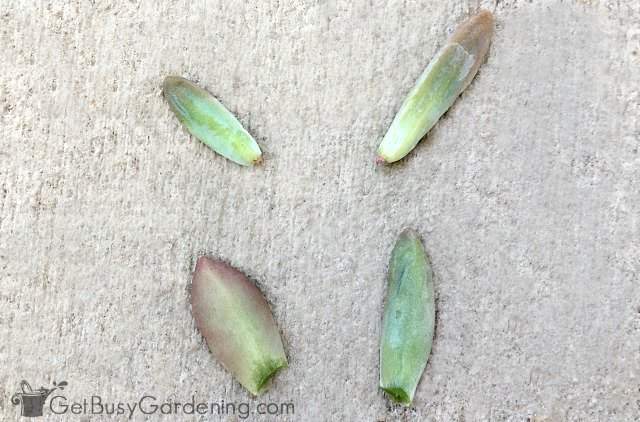
How To Propagate Succulents Step By Step
The best way to propagate succulent cuttings is to plant them in soil. This will give you the best success, and produce stronger, healthier roots. Follow these step by step instructions:
Supplies Needed:
- Prepared stem cuttings or leaves
- Fast-draining soil medium
- Hand trowel
- Rooting hormone
- Clean pot
- Precision pruners or Bonsai shears
See my detailed list of the best plant propagation supplies here.
Step 1: Apply rooting hormone – You can use rooting rooting hormone on succulents to speed up the process. Simply dust the stem or base of the leaf with it. This will help them develop roots much faster, and they’ll be stronger too. But you don’t have to use it if you don’t want to.
Step 2: Fill a container with medium – Fill a small pot with the potting mixture. For best results, I recommend using a very fast draining medium. General potting soil is too heavy, and can cause the cuttings to rot.
Related Post: How To Make Your Own Succulent Soil (With Recipe!)
Step 3: Plant the cuttings – For longer cuttings, make a hole in the medium with a pencil or your finger, and gently place the stem into it so the rooting hormone won’t rub off.
Then lightly pack the medium around the base of the stem so it stays in place, and to ensure the soil comes into good contact with it.
For individual leaves, you can simply lay them on top, or cover them with a very thin layer. Don’t bury them very deep though, just cover the bottom quarter of the leaf, or so.
Step 4: Place somewhere warm and bright – Put the pot in a warm spot with bright, indirect light. Outdoors, make sure they are protected from full sun and heavy rain.
Keep the soil dry, but the air around them slightly humid – if it’s too wet they will rot. For leaves, the medium should be damp, or you can lightly mist them daily.
Step 5: Check for roots – The roots should start forming in a few weeks. You’ll know your succulent cuttings are propagated when you see new leaves growing on the top, and it doesn’t move when you lightly tug on it.
For individual leaves, once the roots are about a 1/2″ long, you can bury them with a thin layer of medium if you want to, but don’t cover any part of the tiny baby plant.
Related Post: How To Water A Succulent Plant
How Long Does It Take To Root Succulents?
It takes anywhere from 2-6 weeks to propagate succulents, but the exact timing depends on the environment and the variety that you have. They will root faster if the air is humid than they will in totally dry conditions.
If you laid individual leaves on top of the medium, then you will be able to watch them as they sprout. A new baby plant will start forming at the base of the leaf shortly after the roots form, but sometimes it can happen before.
Related Post: How To Make An Indoor Succulent Garden
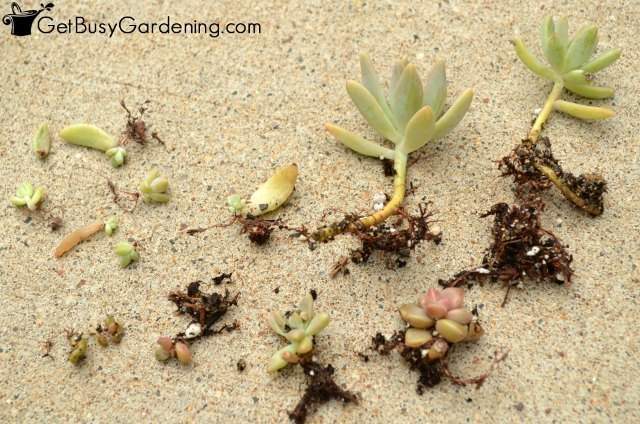
Why Aren’t My Succulent Cuttings Rooting?
If your succulent cuttings are not propagating, then there are a few things to check. They won’t root if it’s too wet, the air is extremely dry and hot, or if it’s too cold. Individual leaves won’t root if you broke them off the wrong way – the entire leaf must be intact for it to work.
For the best chance of success, put them in a bright, warm, and slightly humid location that’s out of direct sunlight, and keep the medium on the dry side. To speed things up, set the pot on a heat mat and use a grow light.
Potting Up Your Rooted Succulent Cuttings
Once they have thick and healthy roots, you can pot up your newly propagated succulent cuttings. But this is optional. If the container they’re in is large enough, you can just leave them be until they outgrow it.
When the time comes, choose a new pot that’s only one or two sizes larger, and make sure it has drainage holes in the bottom. Fill it with a quick draining mix, or a use gritty one, then plant your new babies at the same depth they were in the old container.
Related Post: How To Repot Succulent Plants
FAQs
The best way to propagate succulents is by rooting stem cuttings. You can also use individual leaves as well, but it will take much longer to get a decent sized plant.
You could certainly try propagating your succulents in water. However, this method can be risky because they can quickly rot. If you want to try it, make sure to suspend the cutting above the waterline rather than submerging it.
Propagating succulents is easy, and it’s a great way to multiply your favorites and share them with friends and family. Once you get the hang of it, you’ll have plenty of new babies to go around.
Do you want to learn how to multiply all of your plants? Then my Plant Propagation eBook is for you! It will show all you need to know to get as many new plants as you want from your existing ones. Grab your copy today!
Share your tips for propagating succulents in the comments section below!
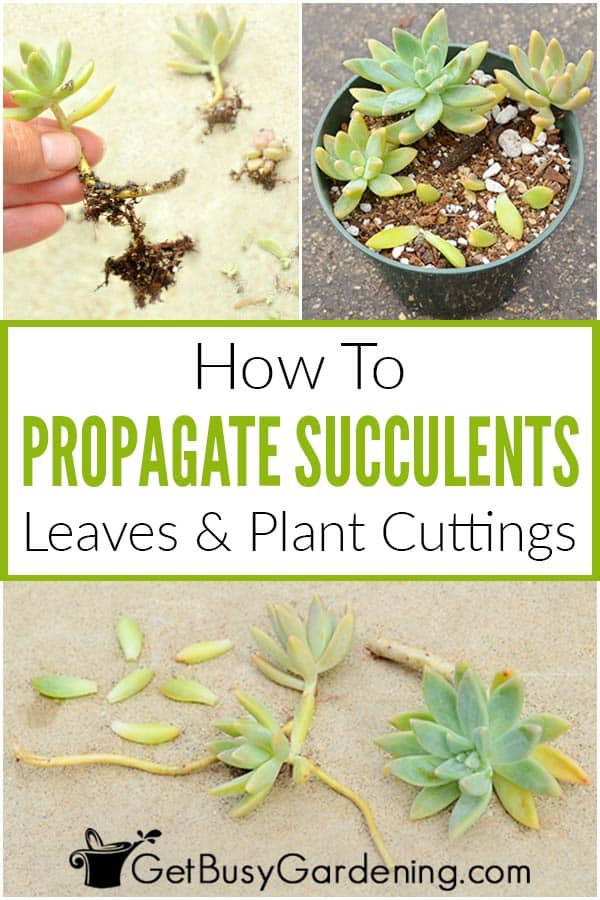
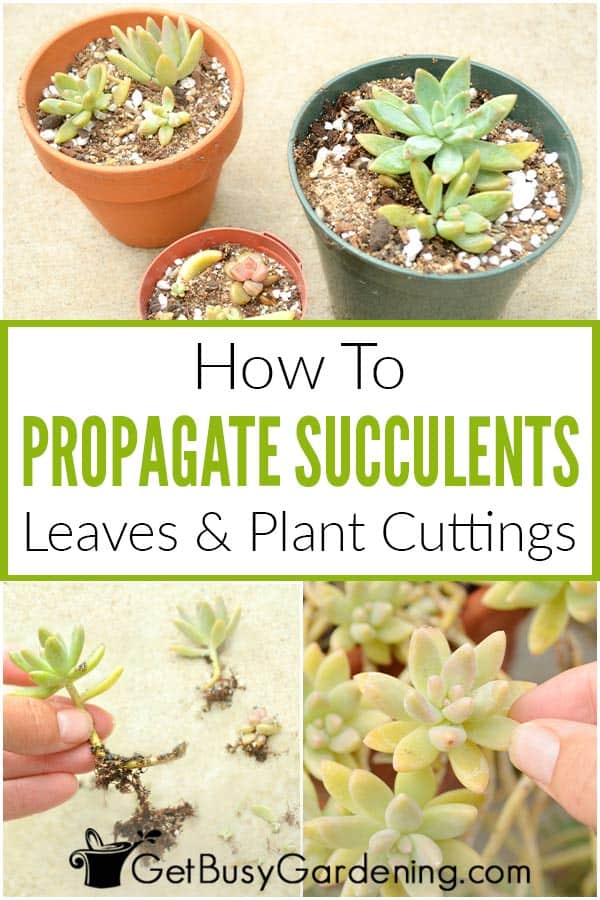
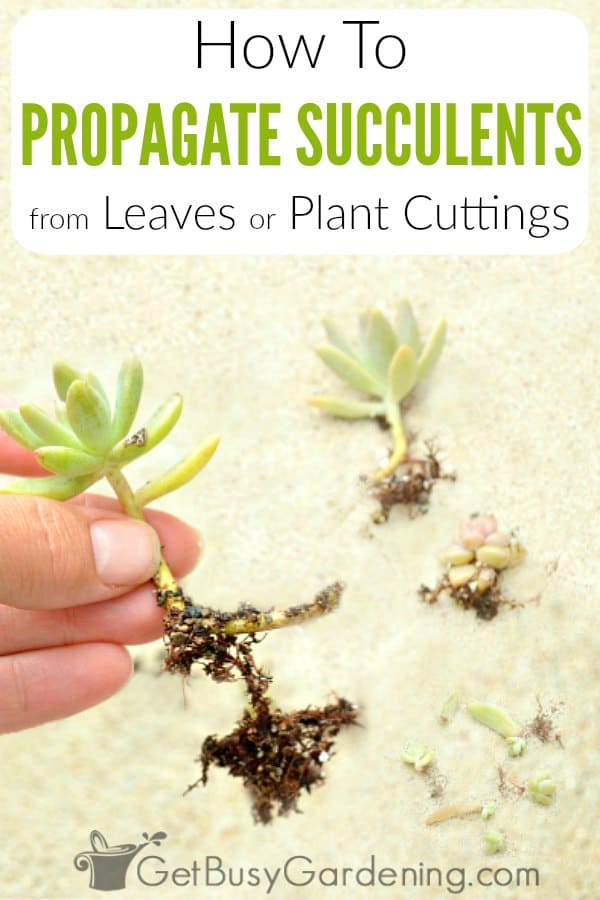
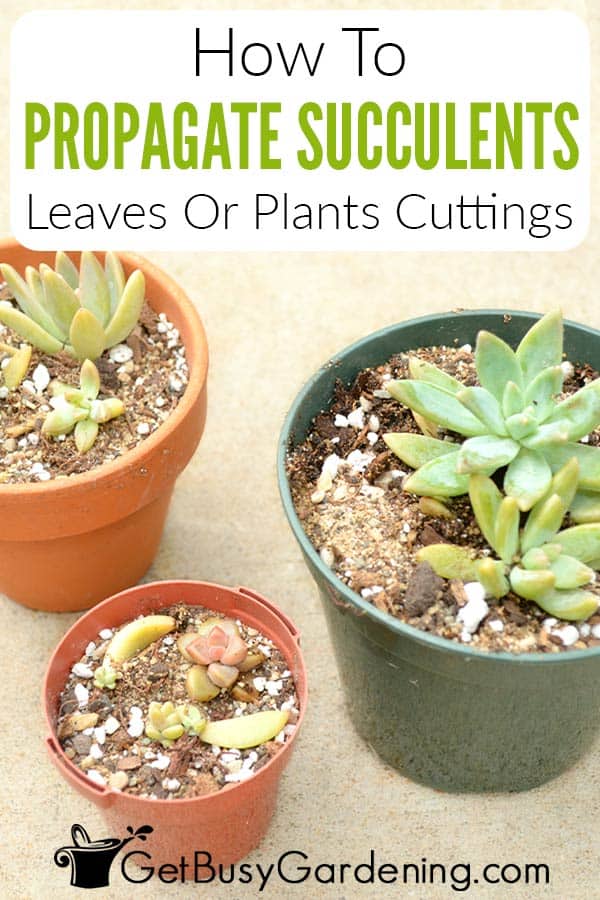
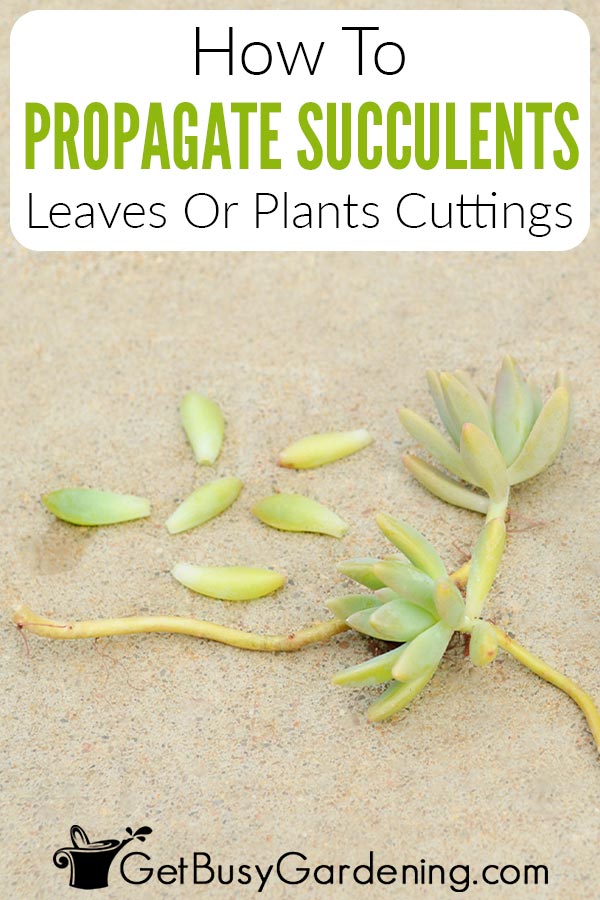
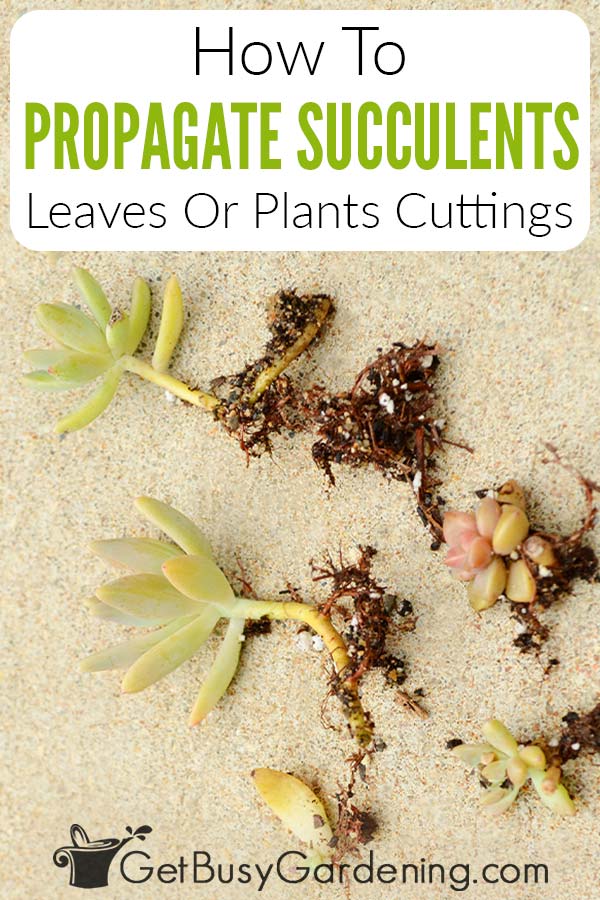
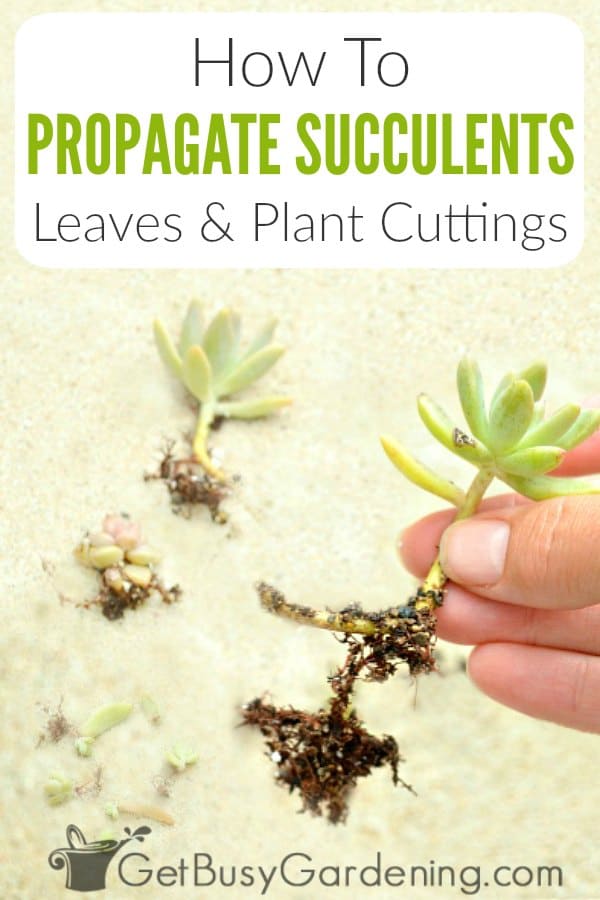
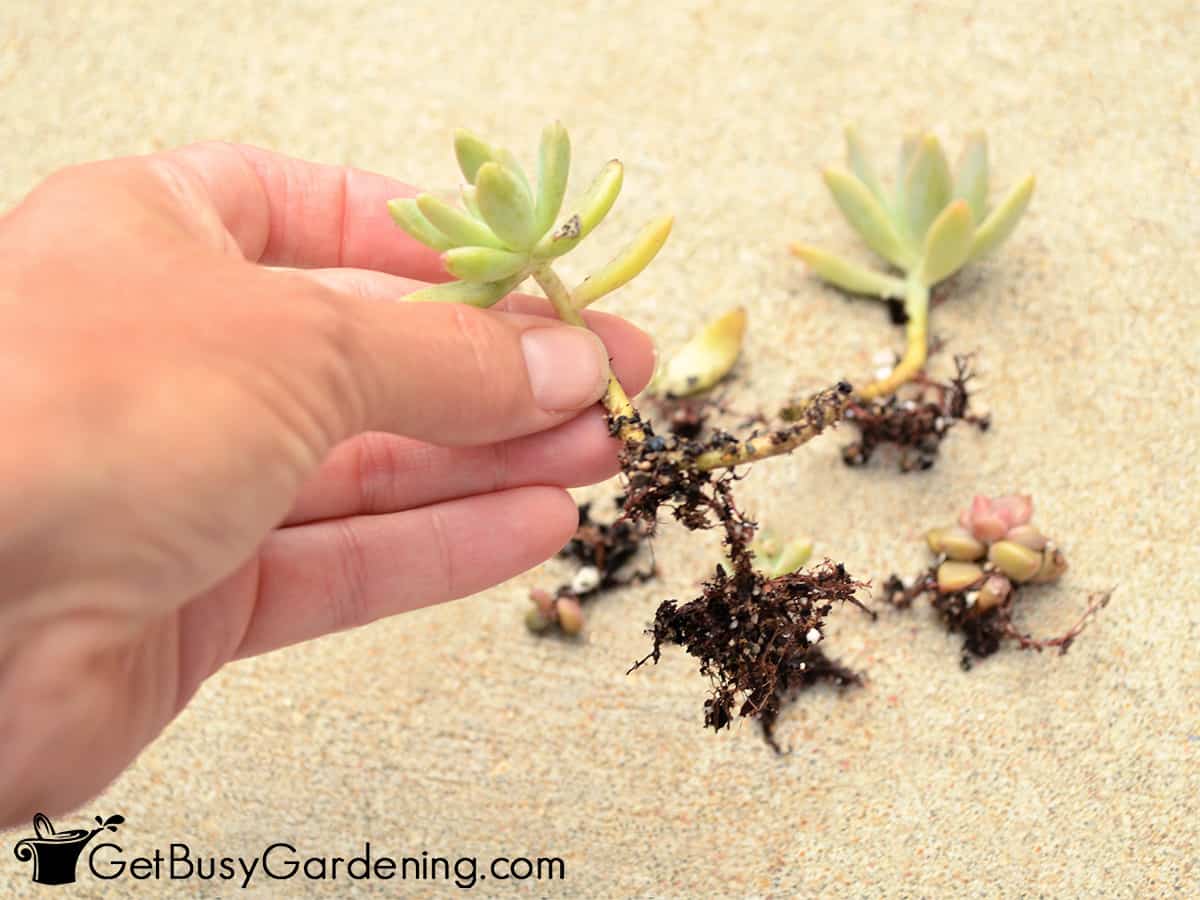

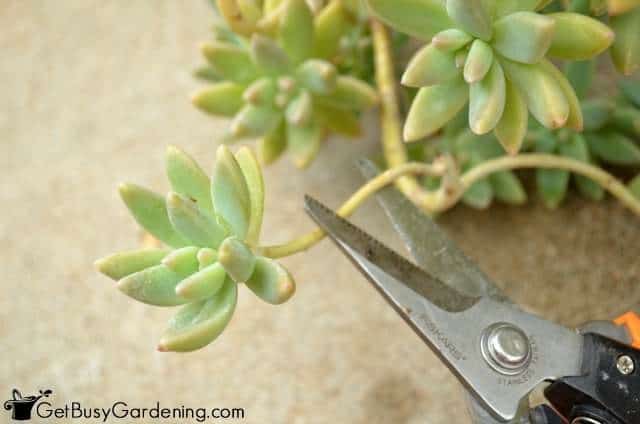
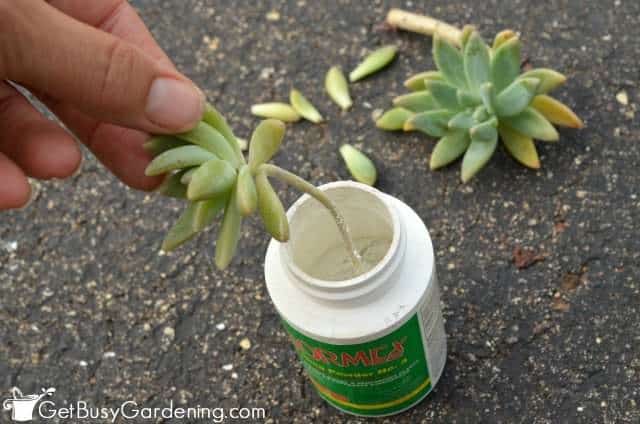
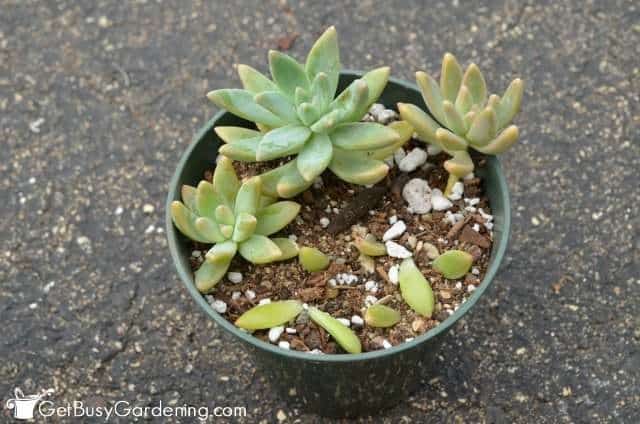
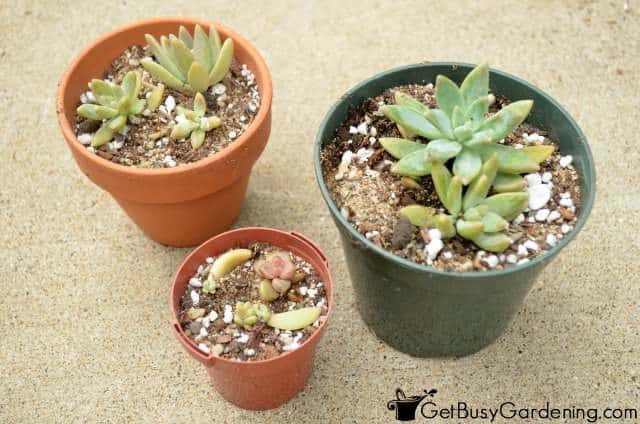


Bonita Boersma says
The plant pictured on your page “Get Busy Gardening.com” is the plant that I took a cutting of, cut into 2 plants and now, want to root. Could you please tell me what the name of the plant is?
I currently have the 2 in water but your article recommends a rooting medium. I’ll see if I have some in the garage.
Hope to hear from you.
Thanks.
Bonita Boersma
Oak Forest, IL
Amy Andrychowicz says
The plant in the photos is a type of ghost plant, I’m not sure of the exact species though. Though you may have success propagating your succulents in water, it is risky, as they can end up rotting instead. It’s a fun experiment if you have lots of extras. But rooting them in soil is the safest method.
Sara says
I have had no luck making babies. I may have messed up by keeping my soil wet. I had to cut the head off of one of my plants and I have a rooting mist. So if the soil is kept dry I should have results right? I’m not supposed to spray water on them at all?
Amy Andrychowicz says
Keeping the soil dry will definitely prevent your succulent cuttings from rotting. If you live in a place where it gets humid during the summer, then you can pretty much ignore them after dusting them with rooting hormone and putting them into the soil, and they will root just fine without your help. If it’s very dry where you live, then you can try misting them very lightly a couple of times a week. However, most times you don’t even need to do that.
Kiki says
Hi Amy, I know someone else already asked this but I just want to make sure I understand correctly! It’s such a reflex to water the soil of a newly planted stem, but in the case of jade there is no water at all, until it starts to form roots. Is that right?
Amy Andrychowicz says
Yes, that is correct. Keep the soil dry, otherwise the succulent cuttings can rot. You can mist them every so often to encourage roots. Here’s a post that is specifically about propagating jade cuttings.
anna says
Hi,
Do you know what the name of the succulent you used in the photos was?
Thanks!
Amy Andrychowicz says
I make my own mix, here’s the recipe… How To Make Your Own Succulent Soil. When using it for propagating succulents, I add a little extra sand and perlite to that mix to give the cuttings even more drainage.
Vianney says
Hi Amy.
I want to ask if I can propagate a succulent cutting in a gritty mix of lava & expanded clay granules.
Thank you.
Amy Andrychowicz says
I’ve never tried using the mix that you describe to root succulent cuttings, so I can’t speak from experience. But I would think it would work just fine, as long as you keep the air around the cuttings humid.
Floranet says
Helpful one! Thank You so much.
Amy Andrychowicz says
You’re welcome!
Tracy says
After I place my succulent cutting in rooting hormone and place in the soil when should I water?
Amy Andrychowicz says
Do not water your succulent cutting until they have grown roots, or you see new growth.
Jeanna Adams says
How can I tell if the leaves I’m propagating are being underwatered or overwatered? Some of them have started to sprout new chicks and others have not. Some leaves are shriveling up like they’re overwatered or underwatered but I’m not sure if the same rules apply for determining an over/under water situation to propagation that applies to full sized plants.
Amy Andrychowicz says
The same rules do not apply for checking the soil moisture of full sized plants -vs- propagating succulent leaves. Full sized plants are a bit more forgiving of being overwatered. Unfortunately, the succulent leaves will rot pretty quickly if they get too much water during propagation. So the best thing to do is err on the side of caution by keeping the soil dry and the air humidity level high. It’s normal for succulent leaves to shrivel as they grow new roots and leaves around the base. Once the baby succulent plant starts to grow, the main leaf will eventually die.
Tawny Leste-Carlson says
Hi Amy! First, congratulations on the publication of your book! So many of us have a book inside of us just SCREAMING TO get out but we’re either too scared to try, scared of rejection if we do try, or we feel like we’re just not good enough. Whether its a childrens book, fictional whodunit, or perhaps giving encouragement and words of wisdom to others who may have experienced the same personal tragedies or setbacks as we have, its something we’d like to share with the world but our fears held us back. It takes guts, bravery, and more than a little vulnerability to even attempt something so huge and you actually DID IT! WOOT WOOT!! If your book is anything like your website you will soon be traveling the world, on huge book tours and hitting the talk show circuit. I’d better get my list together of everything i need help with and submit my questions while you still have time to aswer them lol lol.
Seriously tho, thank you for sharing all of your expertise on a subject you love and have been blessed with gifts of extreme knowledge about, experience to back up that knowledge, and best of all ~ the ability to teach us in such an easygoing and humorous way that it gives us not only the confidence that we can actually SUCCEED but better yet……if we don’t succeed our first couple of times its no biggie, just part of the learning process and eventually, with your help, we WILL succeed! I’ve been following you a long time and never read your bio until tonight and am BEYOND THRILLED you’re right here, in 4b! Every other expert is in Boca Raton or some such heavenly place without a CLUE (and they’re lucky, IMHO ha) of the crazy extremes in temps we and our plants have to deal with. YOU GET IT, thus everything here actually applies to me!
Holy cow I’m one long winded lady and i apologize for that. I have absolutely no concept of long story short. Thank you again. And dress warm!
Amy Andrychowicz says
Wow, thanks so much for your kind words of encouragement about publishing my first book! You gave me warm fuzzies and goosebumps, and made my day! <3 It is a big scary thing, and it was SO MUCH work too!! But in the end, it will be worth it. And don't you worry, I will always be sure to make time to answer questions and comments here on my website! 🙂
Maggie Morish says
Excellent tips!
I’m also thoroughly enjoying caring for my succulents mainly because everything about them seems so easy to do.
Amy Andrychowicz says
Thanks! Yes, succulents are so fun and easy to grow and propagate, I love them too! 🙂